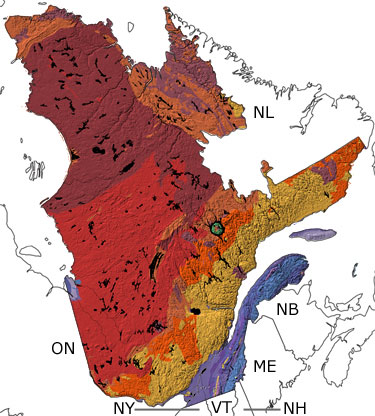

Quebec, Canada |
|||||||||||||||||||||||||||||||||||||||||||||||||||||||||||||||
|
|||||||||||||||||||||||||||||||||||||||||||||||||||||||||||||||
Paleontology and geologyThe Precambrian: The majority of the rocks in Quebec are Precambrian in age. They form part of the Canadian Shield, the core of the North American continent. These igneous, metamorphic, and sedimentary rocks record millions of years of continental collisions and break ups, ancient volcanic islands, and pieces of oceanic crust. Quebec contains some of the oldest rocks known on the surface of the Earth, as well as fossils of stromatolites. The Paleozoic: As part of the continent, northern and central Quebec were exposed above sea level throughout the Paleozoic. Southeastern Quebec was part of the continental shelf and covered by shallow to deep waters that teemed with trilobites, brachiopods, echinoderms, corals, and many other invertebrates. In the Devonian, the shallow seas were filled with many different kinds of early fish, some of which provide important clues about how vertebrates moved onto land. From time to time, the seas over the southeast were so shallow that the water evaporated, leaving deposits of salt and gypsum. Shallow seas also flooded the middle of the continent several times, leaving deposits in small areas of western Quebec. As the supercontinent Pangea came together toward the end of this era, Quebec was near the center. The shallow seas drained away, and many of the rocks were eroded. The Mesozoic: Quebec was above sea level through the Mesozoic. Erosion has removed any rocks deposited during this time, with one exception: the impact crater left by a large asteroid that hit central Quebec in the Triassic. The Cenozoic: Erosion continued to strip away deposits during the Tertiary. In the Quaternary, Quebec was alternately covered by glaciers, forests, and tundra. The glaciers scraped and gouged the exposed bedrock and shaped much of the modern landscape. They picked up and re-deposited sediments around the province. After the glaciers melted, the coastal areas were flooded by marine waters, and fossils of marine invertebrates and vertebrates can be found high above current sea level.
|
|||||||||||||||||||||||||||||||||||||||||||||||||||||||||||||||
Links to more on Quebec paleontology |
|||||||||||||||||||||||||||||||||||||||||||||||||||||||||||||||
|
Organizations | Education and Exhibits | Resources OrganizationsEducation and Exhibits Resources
|
|||||||||||||||||||||||||||||||||||||||||||||||||||||||||||||||
|
site tour |
about the site |
site map |
site credits |
page credits |
help |
FAQs |
contact |
||

